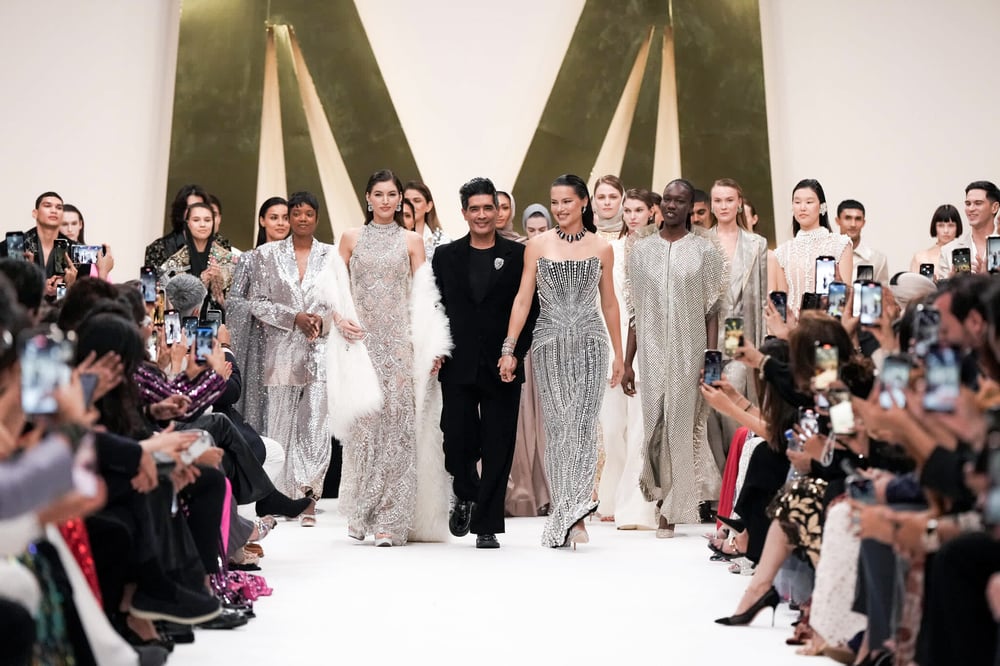Manish Malhotra, a prominent name in the Indian fashion industry, recently completed 35 years working as a costume designer, stylist and fashion designer.
He founded his eponymous fashion label in 2005, which includes couture, bridal wear, and diffusion lines. Since then, the designer has diversified into various verticals, including jewellery, beauty and film production.
FashionNetwork.com spoke with the designer about the brand’s growth strategy, luxury market outlook, sustainable fashion, partnership with Reliance Brands, and his ambitious new project in movie production.

FashionNetwork.com: You recently completed 35 years in the fashion industry. From starting as a costume designer in movies to being India’s most celebrated designer, how has the journey been so far?
Manish Malhotra: My journey has been a long and fulfilling one, filled with passion, challenges, and immense growth. It all started with my childhood obsession with films. Growing up in Bombay, I was captivated by the magic of cinema; how every little detail, from the clothes to the sets, told a story. That curiosity led me to pursue fashion, starting with costume design in films. My first big break came when I designed for Juhi Chawla for the film “Swarg”. It was a turning point that opened doors I never dreamed possible. Of course, the journey wasn’t without its challenges, but I’ve always believed in moving forward with a positive mindset. I truly believe fashion is about evolving, just like life. Over the years, I’ve transitioned from costume design to couture, high jewellery, and now, filmmaking. Each phase of my career has been a learning experience, teaching me the importance of creativity, adaptability, and staying true to my vision.
FNW: How has costume designing in movies changed over the years? And has the evolving consumer behaviour coupled with access to celebrity looks via social media led to a change in costume designing?
MM: Costume designing in cinema has evolved in the most fascinating way. When I started out in the 90s, the focus was very much on glamour and creating iconic, aspirational looks that stayed with the audience long after the film ended. There was a kind of magic to it. Designing for the screen meant creating larger-than-life moments. Today, that landscape has shifted quite significantly. There’s a much greater emphasis on realism and character-driven design. As a designer, that challenges you to dig deeper, to really understand the psychology behind a role before sketching a single silhouette.
And of course, social media has transformed everything. Earlier, you’d watch a film and then maybe read about it in a magazine weeks later. Now, a look from the set, the airport, or a wedding goes viral in seconds. There’s a constant appetite for style, on and off screen. This means that the line between costume and personal style has blurred. So yes, consumer behaviour has had a huge impact. Fashion is more immediate, more influential.
FNW: You have been credited for introducing the concept of a showstopper or celebrity models at fashion weeks. However, the Indian fashion world remains divided on this with many believing it should stop as it completely shifts the show focus onto celebrities. What is your take on this?
MM: When I first started doing shows, the whole idea of a ‘showstopper’ wasn’t a marketing gimmick, it was something very personal. Urmila Matondkar, who is a dear, dear friend, was my first showstopper. We were all young, passionate, trying to do something new. So many of the early showstoppers, whether it was Kareena, Rani, Preity, Karisma, they were all friends, it was about celebrating relationships, storytelling, and merging the worlds of cinema and couture, which I have always deeply believed in.
I understand the debate. There are designers who prefer not to use celebrities, and I respect that. When a star walks the runway, especially when it’s done with intent and authenticity, it elevates the mood, brings visibility, and sometimes even democratizes the experience for the audience watching. But that doesn’t mean I ever compromise on the craftsmanship. The clothes have to speak. The embroidery, the silhouette, the artistry. Whether it’s a model or a showstopper, they wear the story I’ve created.
I also believe models are the backbone of any fashion presentation. They bring their own magic, their talent, their walk, their aura. They are trained professionals who understand how to carry a garment with finesse, and that’s an incredible art in itself. I’ve worked with some of the most phenomenal models who’ve brought my vision to life in ways that words can’t describe. So, it’s never about one versus the other. It’s about harmony, when models, muses, and moments come together to create something unforgettable.
FNW: As per reports, India’s luxury market is among the fastest growing in the world. By 2030, this market could be worth $200 billion. Many luxury brands are entering the Indian market as they see huge potential for growth. Do you see this as an opportunity or challenge and what it means for your brand and the industry as a whole?
MM: The unprecedented rise of India’s luxury market is not just an economic phenomenon, it’s a cultural awakening. As you said that by 2030, as we edge towards that projected $200 billion mark, what we’re truly witnessing is the emergence of a new Indian narrative: one that is unapologetically global yet profoundly rooted in heritage. I believe luxury in India or anywhere is no longer about ostentation; it’s about personal expression, craftsmanship, and legacy.
In that sense, the entry of global luxury brands into India is not competition, it’s context. It forces us to sharpen our voice, elevate our artistry, and stand not just besides, but distinct. The world is finally looking at India with the reverence it deserves, not as a market to be tapped, but as a cultural powerhouse to be celebrated. And for those of us who’ve long believed in the poetry of Indian craftsmanship, this is our renaissance. This is our time.

FNW: Reliance Brands made significant investments in your label by acquiring 40 percent stake in 2021. How has the investment and partnership with Reliance helped the brand so far and what are the future plans?
MM: There was truly no one else I could imagine partnering with other than Reliance. Their deep understanding of the Indian consumer, combined with a global mindset and an unwavering commitment to excellence, made them the perfect fit. It wasn’t just a strategic decision, it was an emotional one. I’ve built this brand from the ground up, and I needed a partner who not only valued that journey but also shared the vision for where it could go next. With Reliance, there’s trust, scale, and the ability to dream without limits. As for the future plans, we are continuously evolving, pushing boundaries, and exploring new frontiers.
FNW: After tapping a segment of the luxury market in India and catering to Indian diaspora abroad, will we see Manish Malhotra with the backing of Reliance move beyond its existing client base and enter the fashion capitals to take on the international brands across the globe? Will we see you tweak designs to cater to international clientele/consumer preferences or are Indian inspired ethnic wear designs ready to make global inroads?
MM: Absolutely, the world is evolving, and so are we. While I cannot reveal too much just yet, I can say that the future is about expanding beyond our existing clientele. The beauty of fashion lies in its fluidity; it’s never about just one market, one culture, or one style. It’s about understanding the nuances of different tastes, while staying true to what we do best. As we continue to grow and evolve, you can certainly expect to see us tap into new territories and global markets. I think what makes us unique is our ability to merge Indian heritage with contemporary aesthetics, something that resonates across cultures. However, each journey takes time, and we will move forward with a lot of thought, vision, and respect for the heritage we represent. There’s so much to look forward to.
FNW: Many designers/luxury brands are turning to affordable collections to cater to a wider audience even though there is an untapped market for luxury wear. How do you see this trend, and will we see Manish Malhotra tweaking its strategy for future growth in India going from elite exclusivity to aspirational?
MM: The beauty of fashion lies in its ability to evolve with the world around us. While luxury has always been the cornerstone of our brand, I’ve long believed in accessibility without compromising on elegance or craftsmanship. That’s why we recently launched MM Ready to Wear, a thoughtful extension of our label that brings the signature Manish Malhotra aesthetic to a wider audience. It is for those who want to experience the magic of design every day, not just on momentous occasions. Indian weddings and celebrations are deeply emotional and personal, and every bride deserves to feel seen and celebrated. That is what we continue to honour, across price points.
At the same time, exclusivity will always remain integral to our identity. Couture is about legacy, about a one-on-one connection between the garment and the wearer. So, while we are expanding our reach, the soul of the brand stays intact.

FNW: With sustainability and eco-consciousness becoming a key concern for the fashion industry, how have you incorporated sustainability practices into your creations? As an industry veteran do you really feel fashion and sustainability can go together, your thoughts?
MM: Sustainability, for me, is not a trend, it’s a value system. As someone who has spent decades in fashion, I’ve always believed in the beauty of craftsmanship, the emotion behind a handwoven textile, and the stories that live within a garment. We work closely with artisans across the country, reviving age-old techniques and weaving them into contemporary design. Every piece is thoughtfully created not to be discarded after a season, but to be treasured, re-worn, and passed down. I’ve never been drawn to fast fashion. It may offer speed, but I’ve always stood for depth, clothes that make you feel something. Fashion and sustainability can absolutely co-exist, but I truly believe it demands intention.
FNW: You have ventured into film production with Stage5. Usually, when someone enters the movie business from a particular field, they take that with them and make movies of similar genres due to their expertise. However, you’ve always said you want to tell stories that are different, does that mean fashion will be completely away from your movies. Tell us about your plans with Stage5?
MM: While my foundation lies in fashion, and it’s a world that continues to inspire me every day, my foray into film production with Stage5 comes from a place that goes far beyond couture. Films were my first love, long before I became a designer.
So, when I say I want to tell stories that are different, I mean stories that surprise, move, and inspire. I don’t want to be boxed into one genre or visual grammar simply because I come from a fashion background. Through Stage5, my vision is to collaborate with brilliant writers, directors, and technicians to explore a wide canvas of themes from dramas to layered social commentaries and stylised commercial entertainers. That said, my eye for detail and visual storytelling, honed over years of costume design and couture, will certainly find its way into the films.
Copyright © 2025 FashionNetwork.com All rights reserved.




